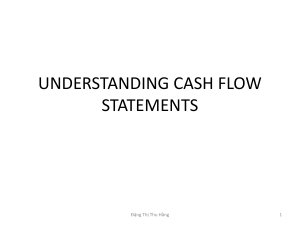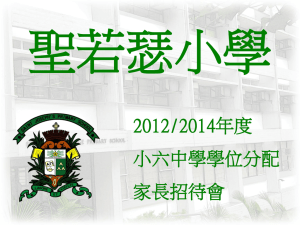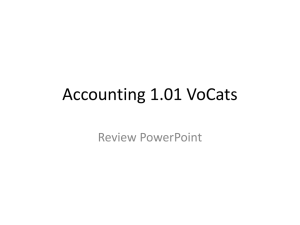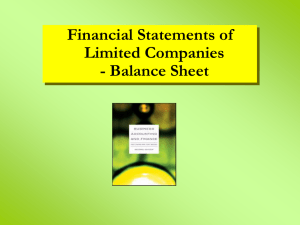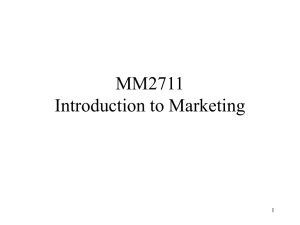UNDERSTANDING BALANCE SHEET
advertisement
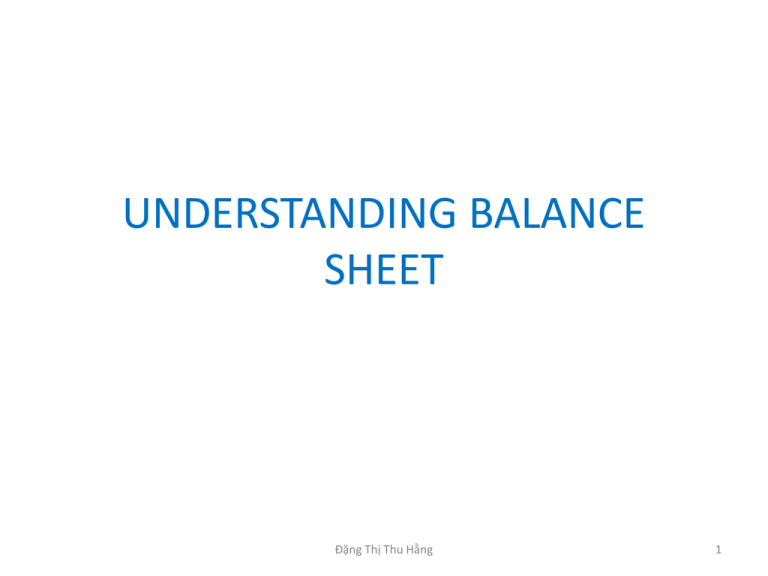
UNDERSTANDING BALANCE SHEET Đặng Thị Thu Hằng 1 ELEMENTS OF THE BS • The balance sheet: reports the firm’s financial position at a point in time. The BS consists of assets, liabilities and equity. • Assets: resources controlled as a result of past transactions that are expected to provide the future economic benefits. Đặng Thị Thu Hằng 2 • Liabilities: obligations as a result of past events that are expected to require an outflow of economic resources. • Equity: the owners’ residual interest in the assets after deducting the liabilities. Equity is also referred to as stockholders’ equity, shareholders’ equity, or owners’ equity. Đặng Thị Thu Hằng 3 LIMITATION OF THE BS • The BS should not be interpreted as market value or intrinsic value. • The BS consists of a mixture of values. • There are a number of assets and liabilities that do not appear on the BS but certainly have value. Đặng Thị Thu Hằng 4 ALTERNATIVE FORMATS OF BS PRESENTATION • The current/ noncurrent format: classified balance sheet and is useful in evaluating liquidity. • Under IFRS: firms can choose to use a liquidity based format if the presentation is more relevant and reliable. Đặng Thị Thu Hằng 5 DISTINGUISH SOME COMPONENTS • Current assets: likely to convert into cash or used up within one year or one operating cycle. • Current liabilities: obligations that will be satisfied within one year or one operating cycle, whichever is greater. Đặng Thị Thu Hằng 6 • Working capital: CA – CR • Noncurrent assets: do not meet the definition of CA but also easily to convert into cash or used up within one year or operating cycle. • Noncurrent liabilities: do not meet the definition of CL, provide information about the firm’s long- term financing activities. Đặng Thị Thu Hằng 7 GOODWILL • Is the excess of purchase price over the fair value of the identifiable net assets (assets minus liabilities) acquired in a business acquisition. Đặng Thị Thu Hằng 8 EXAMPLE • Wood corporation paid $600 million for the outstanding stock of Pine corp. At the acquisition date, Pine reported the following condensed BS Book Value (million) CA $80 Plant and equipment, net 760 Goodwill 30 Liabilities 400 Stockholders’ equity 470 • The fair value of the plant and equipment was $120 million more than its recorded book value. The fair value of all other identifiable assets and liabilities were equal to their recorded book values. Calculate the amount of goodwill Wood should report on its consolidatedĐặng BS.Thị Thu Hằng 9 • Goodwill is only created in a purchase acquisition. Internally generated goodwill is expenses as incurred. • Goodwill is not amortized but must be tested for impairment at least annually. • Accounting goodwill # economic goodwill. Economic goodwill derives from the expected future performance of the firm, while accounting goodwill is the result of past acquisitions. Đặng Thị Thu Hằng 10 ESSAY • Explain the concept of Goodwill. Give an example of a brand name of a Vietnamese company that would require additional costs above book value to acquire. (Each group write within 250 -300 words for this essay) Đặng Thị Thu Hằng 11 FINANCIAL ASSETS • are measured at historical cost, amortized cost or fair value. • Measured at amortized cost = held to maturity securities. • Measured at fair value = mark to market accounting Đặng Thị Thu Hằng 12 Historical cost Amortized cost Fair value •Unlisted equity Held to maturity investments securities •Loans and receivables Đặng Thị Thu Hằng •Trading securities •Available for sale securities •Derivaties 13 EXAMPLE • Triple D Cor. Purchased a 6% bond, at par, for $1.000.000 at the beginning of the year. Interest rates have recently increased and the market value of the bond declined $20.000. Determine the bond’s effect on Triple D’s financial statements under each classification of securities. Đặng Thị Thu Hằng 14 COMMON SIZE BS • A vertical common size balance sheet: expresses each item of the BS as a percentage of total assets. Đặng Thị Thu Hằng 15 East West Cash $2.300 1.500 Accounts receivable 3.700 1.100 Inventory 5.500 900 Current assets 11.500 3.500 Plant and equipment 32.500 11.750 Goodwill 1.750 0 Total assets 45.750 15.250 Current liabilities 10.100 1.000 Long term debt 26.500 5.100 Total liabilities 36.600 6.100 Equity 9.150 9.150 Total liabilities & equity 45.750 15.250 Đặng Thị Thu Hằng 16 East (%) West (%) Cash 5 10 Accounts receivable 8 7 Inventory 12 6 Current assets 25 23 Plant and equipment 71 77 Goodwill 4 0 Total assets 100 100 Current liabilities 22 7 Long term debt 58 33 Total liabilities 80 40 Equity 20 60 Total liabilities & equity 100 100 Đặng Thị Thu Hằng 17 CALCULATE Currentass ets Currentrat io Currentlia bilities Cash Marketable sec urities Re ceivables Quickratio Currentlai bilites Đặng Thị Thu Hằng 18 Cash Marketable sec urities Cashratio Currentlia bilities Totaldebt totaldebttoequity Totalequity totaldebt debtratio totalasset s totalassets Financialleverage totalequity Đặng Thị Thu Hằng 19 EXERCISE 1 • - Create the Balance sheet: Cash on hand: 25.000 USD Cash in bank: 300.000 USD Payable to suppliers: 289.000 USD Rights to use land: 150.000 USD Workshops: 360.000 Capital: 600.000 Đặng Thị Thu Hằng 20 EXERCISE 2 • The company ABC was established with the initial capital is 600 million USD, which included 400 million cash in the bank and 200 million cash on hand. 1. Buy the fixed assets and pay cash is 80 million USD 2. Buy materials about 60 million USD which pay by cash is 50 million USD and the rest will be paid within 60 days 3. Buy tools about 2 million USD and pay by cash. Đặng Thị Thu Hằng 21
